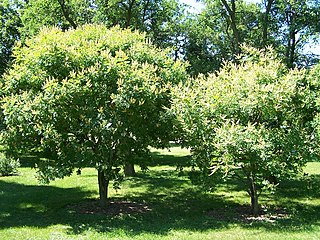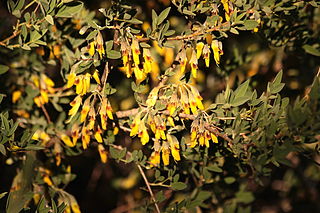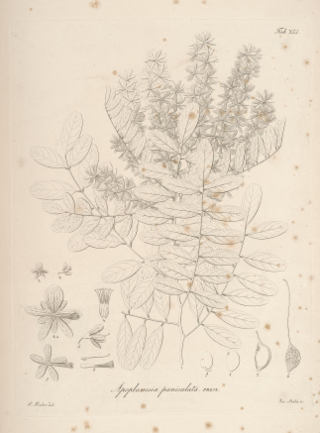
Chamaecytisus is a genus of flowering plants in the legume family, Fabaceae. It includes 43 species which range from the Canary Islands and Morocco through mainland Europe to western Siberia, Kazakhstan, the Caucasus, Anatolia, and the eastern Mediterranean. It belongs to the subfamily Faboideae. It may be a synonym of Cytisus.

Aotus is an Australian genus of flowering plants, within the legume family Fabaceae. Aotus species, together with other species of the tribe Mirbelieae, are often called golden peas because of their distinctive small yellow flowers. They are endemic to Australia, occurring in all states except the Northern Territory. Aotus are evergreen species. Some are widely cultivated by gardeners for their ornamental value.

Baptisia is a genus in the legume family, Fabaceae. They are flowering herbaceous perennial plants with pea-like flowers, followed by pods, which are sometimes inflated. They are native to woodland and grassland in eastern and southern North America. The species most commonly found in cultivation is B. australis.

Maackia is a genus of flowering plants in the legume family, Fabaceae. There are about 12 species, all native to eastern Asia, with six endemic to China. The generic name honors the botanist Richard Maack.

Thermopsis is a genus of legumes, native to temperate North America and east Asia. They are herbaceous perennials and are known as goldenbanners or false-lupines.
Neoharmsia is a genus of legume in the family Fabaceae.

Pericopsis is a genus of legume in the family Fabaceae.
Sakoanala is a genus of legume in the family Fabaceae. It contains two species which are endemic to Madagascar.

Psorothamnus is a genus of plants in the legume family. These are shrubs and small trees. Many are known by the general common name indigo bush. Some are referred to as daleas, as this genus was once included in genus Dalea. These are generally thorny, thickly branched, strongly scented bushes. Most species bear lupinlike raceme inflorescences of bright purple legume flowers and gland-rich pods. Psorothamnus species are native to the southwestern United States and northern Mexico. The genus is paraphyletic and it has been proposed that the genus Psorodendron be reinstated to accommodate sections Xylodalea, Capnodendron, and Winnemucca.

Adenolobus is a genus of African flowering plants in the legume family, Fabaceae. It belongs to the subfamily Cercidoideae.

Barklya is a genus of Australian trees in the legume family, Fabaceae. It belongs to the subfamily Cercidoideae. The sole species is Barklya syringifolia, commonly known as golden crown or golden glory. It grows in rainforest to 20 metres tall. Recorded from Queensland and New South Wales in rain forest. It is often used as an ornamental.
Baudouinia is a genus of flowering plants in the legume family, Fabaceae. It includes six species which are all endemic to Madagascar. It belongs to the subfamily Dialioideae.

Griffonia is a genus of central African flowering plants in the legume family, Fabaceae. It belongs to the subfamily Cercidoideae. Griffonia is known to have a high concentration of 5-HTP in its seeds.

Anagyris is a genus of flowering plants in the family Fabaceae. It belongs to the subfamily Faboideae.

Apoplanesia is a genus of flowering plants in the family Fabaceae. It belongs to the subfamily Faboideae.

Calicotome is a genus of flowering plants in the family Fabaceae. It includes five species native to the Mediterranean Basin. The genus belongs to the subfamily Faboideae. It may be synonymous with Cytisus. All species of the genus are thorny shrubs. The ancient Greeks believed that tyrants in Hades were punished by being beaten with the thorny calycotomes.
Latrobea is a genus of flowering plants in the legume family, Fabaceae. It belongs to the subfamily Faboideae. The plant is named after Charles Joseph La Trobe.
Platycelyphium voense is a species of flowering plant in the family Fabaceae. It belongs to the subfamily Faboideae. It is the only member of the genus Platycelyphium.
Spirotropis is a genus of flowering plants in the family Fabaceae. It belongs to the subfamily Faboideae.
Lasiobema was a genus of flowering plants in the legume family, Fabaceae, most of which are lianas, belonging to the subfamily Cercidoideae. It was recently (2010) synonymized with Phanera on the basis of morphology, although this was questioned and it can be treated as a section of this genus.













